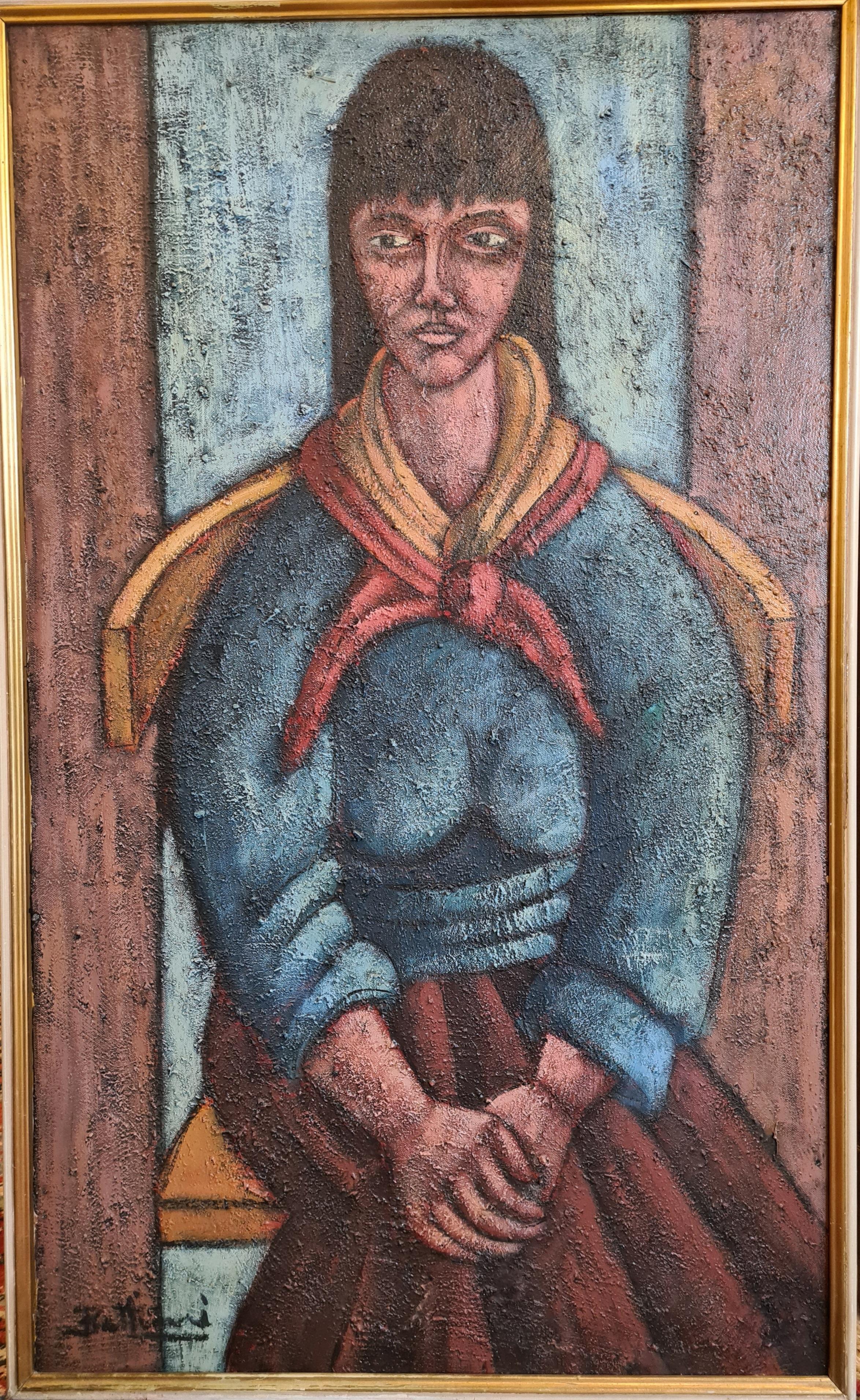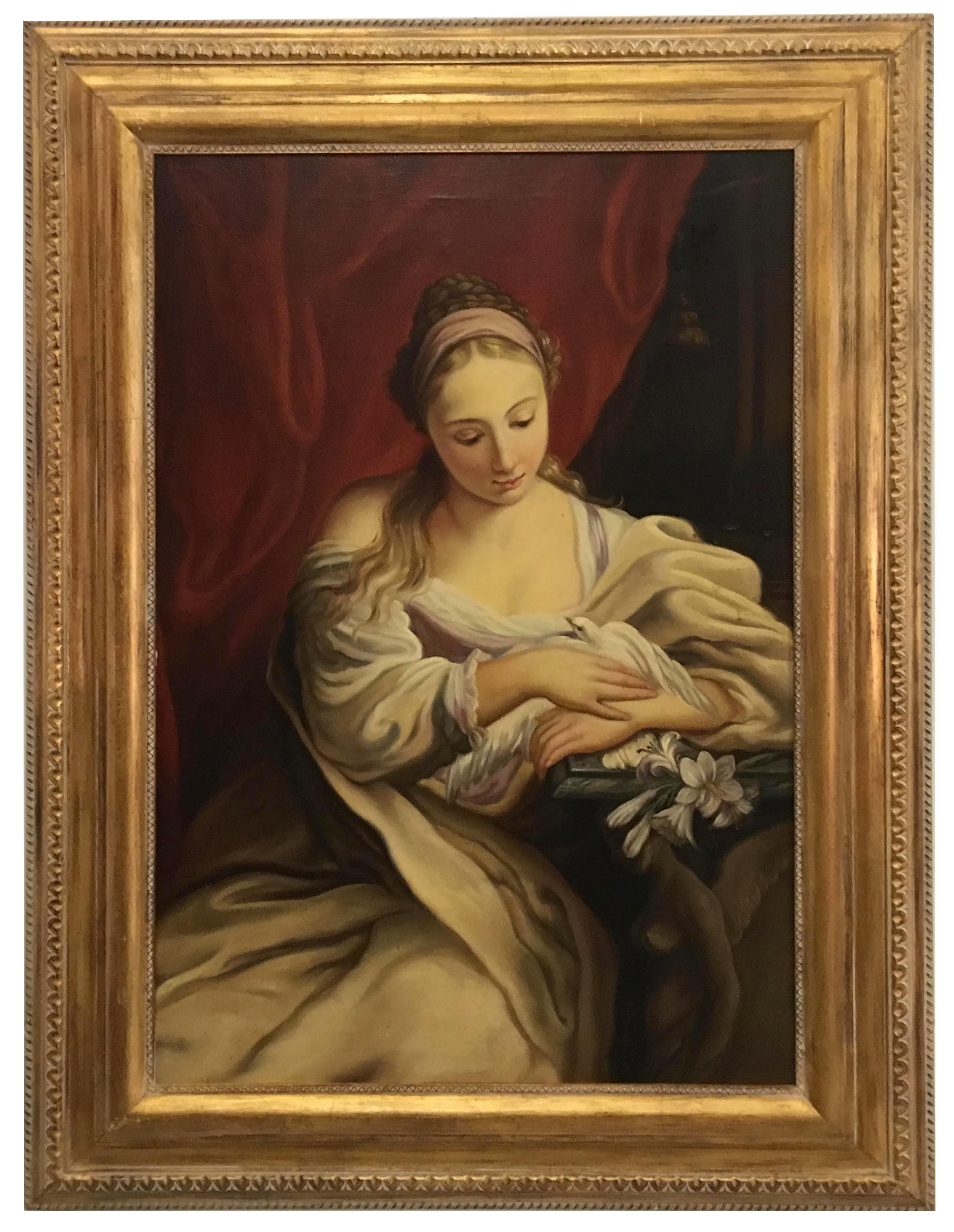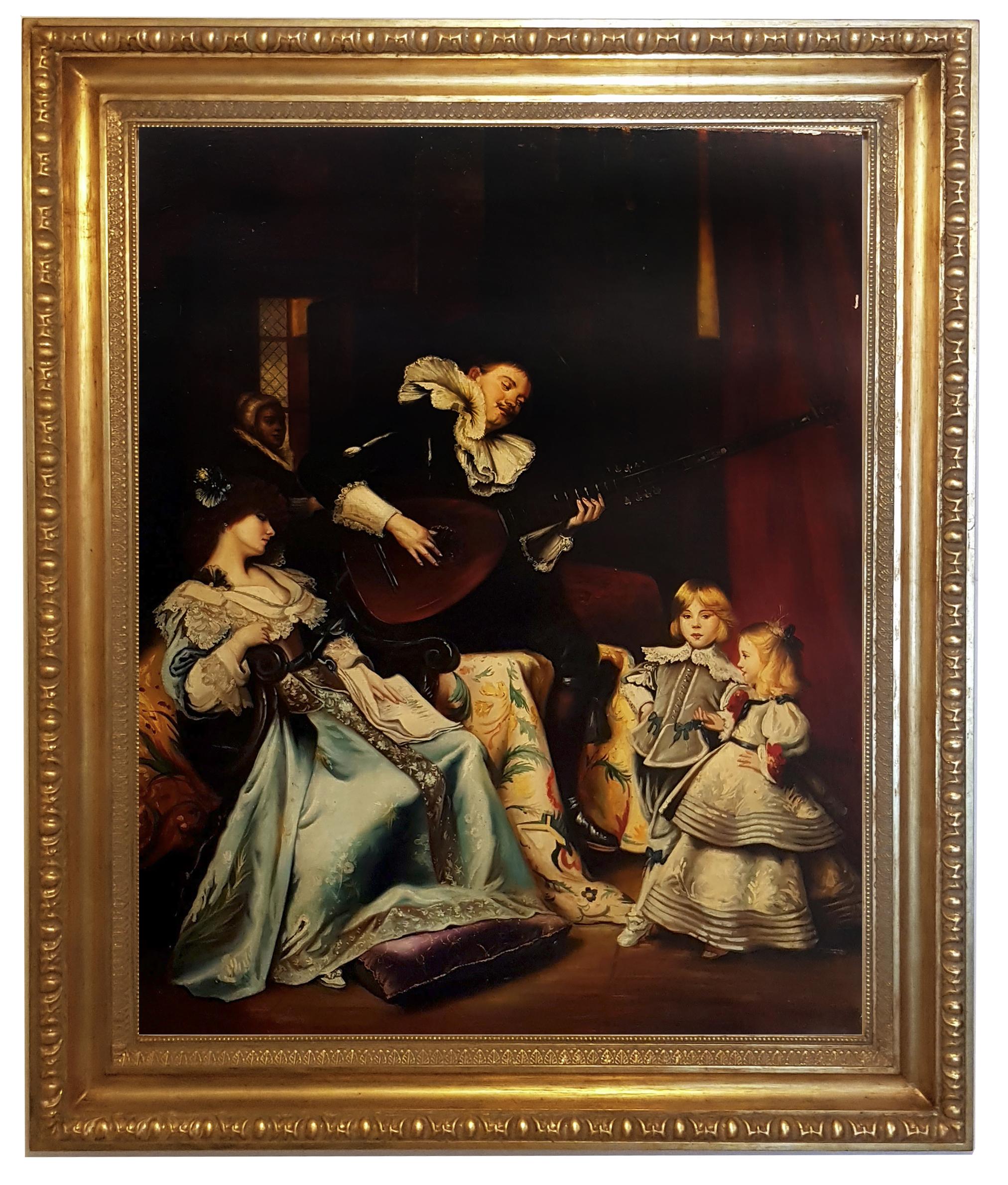Items Similar to Men portrait
Want more images or videos?
Request additional images or videos from the seller
1 of 11
Giovanni Maria delle Piane dit Mulinaretto (Genoa 1670 - Monticelli d´Ongina 1745)Men portraitcirca 1730
circa 1730
About the Item
Giovanni Maria DELLE PIANE, known as IL MULINARETTO
(Genoa, 1660 – Monticelli d'Ongina, 1745)
Portrait of a man
Oil on oval canvas
H. 108 cm; L. 83 cm
Provenance: Nino Ferrari Collection, Genoa, 1922
Exhibition: 1922, “Mostra della pittura italiana del Seicento et del Settecento”, Florence, Palazzo Pitti, n° 707 (Label on the frame)
The artist, better known as his nickname Mulinaretto, inherited from a miller grandfather, was born in Genoa in 1660. At the age of ten, he began attending the workshop of Giovan Battista Merano, where he completed his apprenticeship as a painter and where There he remained until 1676, when he moved to Rome, to improve under the direction of Giovan Battista Gaulli, il Baciccio. It was during this stay in Rome, which lasted about eight years, that the young man developed “the frank ability to translate with accuracy the most delicate and difficult physiognomies on the canvas” (Ratti 1769, p. 147). , thus demonstrating a remarkable aptitude for portraiture. Returning to Genoa in 1684, he was thus able to take advantage of his ability to paint humans, responding to the taste of the local clientele who recognized him as a gifted, sensitive artist, skilled in satisfying their needs for social recognition, according to a taste which was changing during this decade. The first works of the Mulinaretto, such as the portraits of the doge Pietro Durazzo (Genoa, National Gallery of Palazzo Spinola), of Gian Battista Cattaneo and his wife Maddalena Gentile with a daughter (Genoa, former collection of the Società Levante Assicurazioni) are included still in the style of Genoese portraiture from the first half of the 17th century, according to the methods of Gio Bernardo Carbone, a disciple of Van Dyck. It was probably towards the end of the century, during the last decade of the 17th century, that the artist renewed his style, adapting to the new fashion for French portraiture in the genre of Rigaud and Largillièrre. Works such as the portraits of the Doria House and the Durazzo House are characterized by a pleasant “worldliness” and a refined invention of backgrounds, sometimes even sumptuous. In 1695, il Mulinaretto, invited by Count Morando, made his first trip to Parma, a city in which he stayed several times, finding favor with the Farnese family: in 1706, the artist painted the portrait of Duke Francesco, of the Duchess Dorothée and Princess Elisabetta Farnese. After also making a few trips to Milan, Delle Piane moved to Parma in 1709, where he was appointed court painter. He returned to Genoa several times to respond to commissions, around 1714 and 1715, where he immortalized Elisabetta Farnese on the occasion of her marriage to Philip V of Spain; in this same period he lived in Piacenza, where he remained until 1737. It was probably in these years, around the middle of the second decade of the 18th century, that the artist found a more personal way, in which his various cultural references emerge, mixing its Italian and French inspirations. In 1719, il Mulinaretto declined the invitation to go to Spain, probably given by Elisabetta Farnese. Several years later, in 1737, he spent a stay in Naples, at the court of Charles Bourbon, son of Elisabetta. As a chamber painter, he depicted King Charles and his wife there. In 1741, the artist left Naples for Genoa, where he still painted the local nobility before retiring in 1744 to Monticelli d'Ongina near Piacenza, where he died the following year.
- Creator:Giovanni Maria delle Piane dit Mulinaretto (Genoa 1670 - Monticelli d´Ongina 1745) (1670 - 1745, Italian)
- Creation Year:circa 1730
- Dimensions:Height: 42.52 in (108 cm)Width: 32.68 in (83 cm)
- Medium:
- Movement & Style:
- Period:1730-1739
- Condition:Perfect condition. Cleaned.
- Gallery Location:BELEYMAS, FR
- Reference Number:1stDibs: LU1860214302302
About the Seller
No Reviews Yet
Vetted Seller
These experienced sellers undergo a comprehensive evaluation by our team of in-house experts.
Established in 2011
1stDibs seller since 2022
- ShippingRetrieving quote...Ships From: BELEYMAS, France
- Return PolicyThis item cannot be returned.
More From This SellerView All
- Attilio Manganaro (c.1865-c.1890) - Portrait of Gabriele d’Annunzio in 1887By Attilio ManganaroLocated in BELEYMAS, FRAttilio MANGANARO (c.1865 – c.1890) Portrait of Gabriele d'Annunzio in 1887 Oil on canvas H. 52 cm; L. 42 cm Signed and dated lower right 1887 On the...Category
1880s Italian School Figurative Paintings
MaterialsOil, Canvas
- Presumed portrait of Princess de Conti, Marie-Anne de BourbonBy Nicolas de LargillièreLocated in BELEYMAS, FRNicolas de LARGILLIERRE (Paris 1656 – 1746) Portrait of a woman, presumed to be Marie-Anne de Bourbon, Princess of Conti (1666-1739) Oil on oval canvas H. 80 cm; L. 61 cm (107 x 91 c...Category
1730s French School Figurative Paintings
MaterialsCanvas, Oil
- Sketch of a dandy portraitLocated in BELEYMAS, FRFrench school circa 1840 Sketch of a dandy portrait Oil on canvas mounted on cardboard H. 21 cm; L. 20.5 cmCategory
1830s French School Figurative Paintings
MaterialsCanvas, Oil
- Portrait of a man in armorLocated in BELEYMAS, FRAttributed to Jacques DUMONT aka DUMONT LE ROMAIN (Paris 1701 - 1781) Presumed portrait of Louis-Joseph de Formanoir (?-1732) Oil on canvas H. 91.5 cm; ...Category
1750s French School Figurative Paintings
MaterialsCanvas, Oil
- Charles Fréchou - Child portrait with a catLocated in BELEYMAS, FRCharles FRÉCHOU (Paris 1820 – Paris 1900) Portrait of a child with a cat Oil on canvas H. 41 cm; L. 33 cm Signed lower left and dated 1849 Apart from participation in the Salon betw...Category
1810s French School Figurative Paintings
MaterialsCanvas, Oil
- French King Louis-Philippe - After Baron GérardLocated in BELEYMAS, FRAfter Baron Gérard, circa 1835 Portrait of King Louis-Philippe Oil on canvas H. 79 cm; L. 65 cm Provenance : Private collection, Périgord, by descent since the 19th century This po...Category
1830s French School Figurative Paintings
MaterialsCanvas, Oil
You May Also Like
- LADY'S PORTRAIT - Venetian School - Oil on Canvas Italian Figurative PaintingBy Giovanni SantanielloLocated in Napoli, ITLady's portrait - Giovanni Santaniello Italia 2002 - Oil on canvas cm. 100 x 80 The painting by Giovanni Santaniello depicts a portrait of a beautiful pensive woman in elegant clothe...Category
Early 2000s Italian School Portrait Paintings
MaterialsOil, Canvas
- Woman Seated in a Klismos Chair. Italian School, Transavantgarde Oil on Canvas.Located in Cotignac, FRMid 20th Century Italian portrait of a seated lady signed Battionni bottom left. Presented in a white and gilt wood frame. A characterful stylised...Category
Mid-20th Century Italian School Figurative Paintings
MaterialsCanvas, Oil
- PORTRAIT OF YOUNG WOMAN - Venetian School -Italian oil on canvas paintingBy Eugenio De BlasiLocated in Napoli, ITPORTRAIT OF YOUNG WOMAN - Oil on canvas painting cm.95x65, Eugenio De Blasi, Italy, 2008 The painting by Eugenio De Blasi is inspired by the work of the Venetian painter and portrai...Category
Early 2000s Italian School Figurative Paintings
MaterialsCanvas, Oil
- AUTUMN'S ALLEGORY - Eugenio De Blasi - Italian Portrait Italian Oil on CanvasBy Eugenio De BlasiLocated in Napoli, ITAutumn's Allegory - Oil on canvas cm.60x50, Italia, 2007, Eugenio De Blasi (3c59a) The painting by Eugenio De Blasi is an autumn allegory inspired by the allegorical figures of the ...Category
Early 2000s Italian School Portrait Paintings
MaterialsCanvas, Oil
- SCENE WITH MINSTREL- Eugenio De Blasi - Italy -Oil on canvas paintingBy Eugenio De BlasiLocated in Napoli, ITScene with Minstrel - Oil on canvas painting, Eugenio De Blasi, Italy, 2005 This is his reinterpretation of a greatest old master painting by Giovanni Boldini.Category
Early 2000s Italian School Figurative Paintings
MaterialsCanvas, Oil
- LADY IN BLACK-In the Manner of G. Bodini Italy figurative oil on canvas paintingBy Eugenio De BlasiLocated in Napoli, ITLADY IN BLACK - Oil on canvas painting, Eugenio De Blasi, Italy, 2011 This is his reinterpretation of a greatest old master painting by Giovanni Boldini. Gold leaf gilded and mohogan...Category
Early 2000s Italian School Figurative Paintings
MaterialsOil, Canvas





